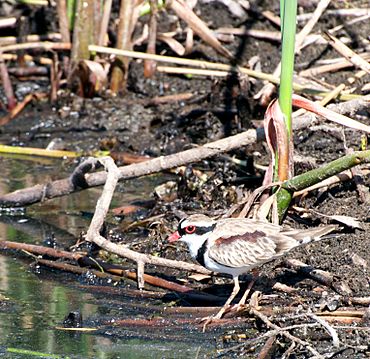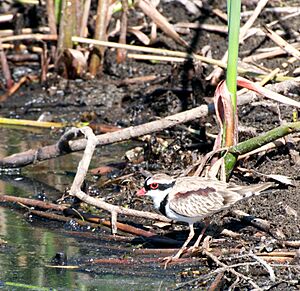Narran Wetlands facts for kids
Quick facts for kids Narran Lakes Nature ReserveNew South Wales |
|
|---|---|
|
IUCN Category Ia (Strict Nature Reserve)
|
|

The wetlands are important for black-fronted dotterels
|
|
| Nearest town or city | Brewarrina |
| Established | October 1988 |
| Area | 264.8 km2 (102.2 sq mi) |
| Visitation | Closed to the public |
| Managing authorities | NSW National Parks & Wildlife Service |
| Website | Narran Lakes Nature Reserve |
| See also | Protected areas of New South Wales |
The Narran Wetlands, also called the Narran Lakes, are a special nature reserve in New South Wales, Australia. This area has many lakes and swamps that fill up with water at different times. They are fed by the Narran River. The reserve covers about 26,480 hectares (that's like 65,000 acres!). It's located about 50 kilometers east of Brewarrina.
A big part of the reserve, about 8,447 hectares, is super important. It's protected under something called the Ramsar Convention. This means it's recognized worldwide as a vital wetland. It's special because it's rare and very natural. It's also a crucial home for many waterbirds, especially when they come to breed. This area helps birds survive during dry times.
Contents
What Makes Narran Lakes Special?
The Narran Wetlands are formed by the Narran River, which is a branch of the Balonne River. This area is found between the towns of Brewarrina and Walgett. It's part of the larger Murray-Darling Basin.
The wetlands have three main open water areas. These are Clear Lake and Back Lake in the north, and Narran Lake (also known as Terewah) in the south. These lakes are connected by areas of plants that get flooded.
Plants of the Wetlands
The wetlands are home to many plants. You'll find thick stands of lignum plants. In some places, there are tall river red gums or belalie trees. These plants are very important. They provide places for waterbirds to build their nests and raise their young. The plants need regular flooding to stay healthy and alive.
The area usually gets about 495 millimeters of rain each year. The land around the wetlands is mostly dry. It's used for grazing animals like cattle and sheep.
Protecting the Water
The plants and waterbird colonies in Narran Lakes need enough water to survive. However, sometimes less water flows into the wetlands. This happens because water is taken from the river upstream in Queensland. This water is used for farming. This can put the plants and birds at risk.
Amazing Birds of Narran Lakes

The Narran Wetlands are known as an Important Bird Area by BirdLife International. This means they are very important for birds around the world. When the wetlands are flooded, huge numbers of waterbirds come here to nest.
Bird Species and Their Importance
- One of the biggest groups of birds here is the straw-necked ibis. There can be up to 200,000 pairs nesting at once!
- More than 1% of the world's Australian pelicans and black-fronted dotterels live here.
- You might also see small numbers of the endangered Australasian bittern.
Other birds that gather in large numbers include:
- Pied cormorants
- Little black cormorants
- Great cormorants
- Freckled ducks
- Pink-eared ducks
- Black swans
- Glossy ibises
- Whiskered terns
- Royal spoonbills
- Darters
History of the Area
The land around Narran Lakes has a long history with Australia's First Peoples. The Yuwaalayaay language is an Aboriginal language spoken in this area. It is closely related to the Gamilaraay and Yuwaalaraay languages.
The Yuwaalayaay language region covers a wide area. This includes places like Dirranbandi in Queensland and Goodooga and Walgett in New South Wales. It also includes the Narran Lakes. This shows the deep connection between the Yuwaalayaay people and this special land.
Images for kids



